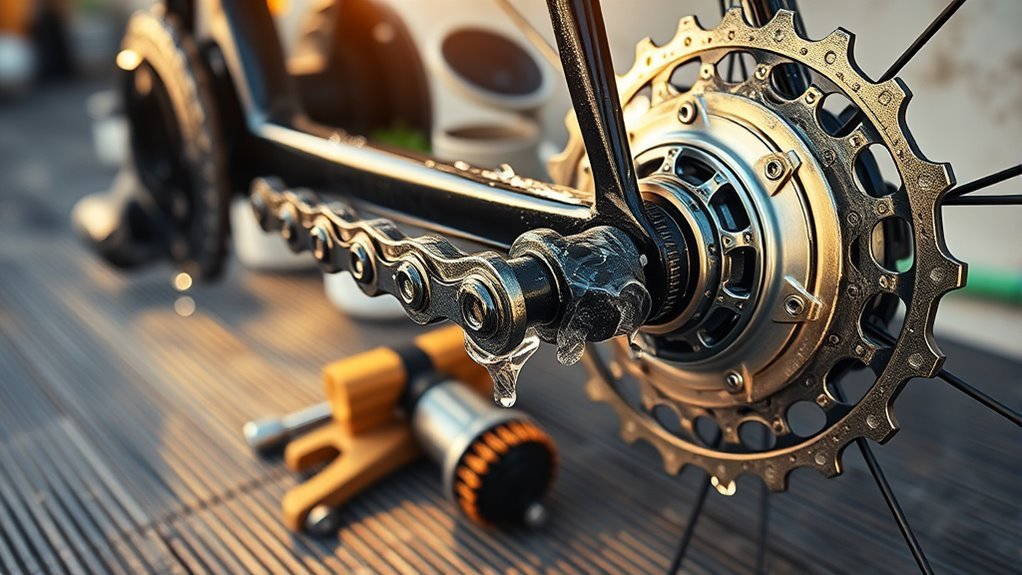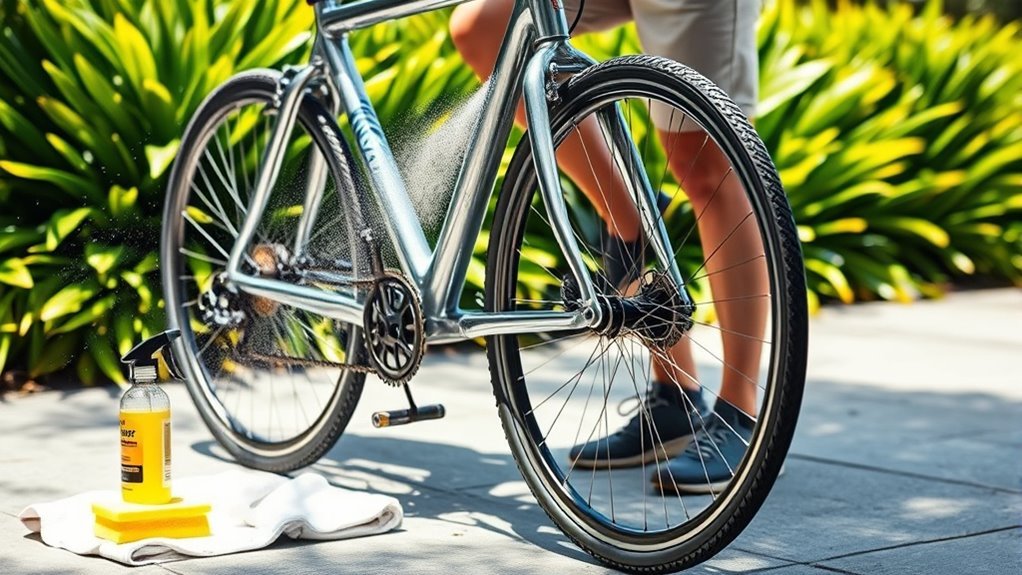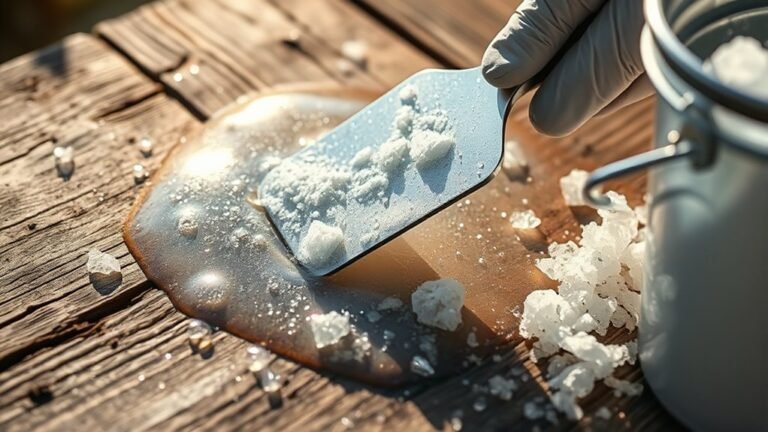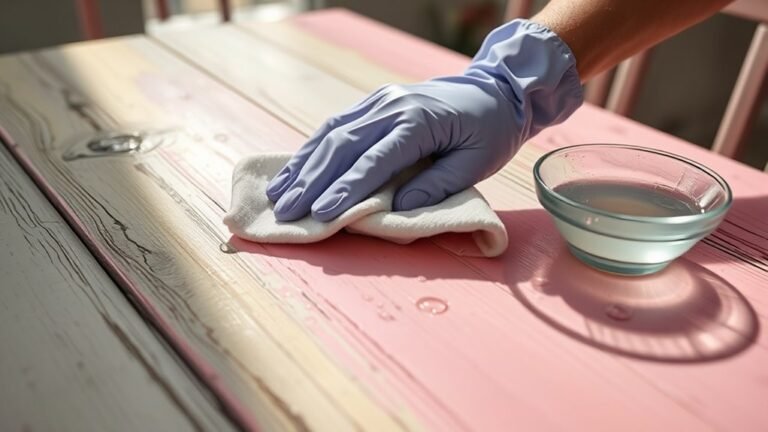How to Clean Your Bike in 10 Minutes
To clean your bike in 10 minutes, gather basic supplies like a soft brush, sponge, mild soap, and lubricant. Quickly rinse off loose dirt with a gentle spray. Scrub the drivetrain with degreaser and a brush, then wipe down the frame and wheels using a microfiber cloth. Dry your bike thoroughly to prevent rust, and apply lubricant to the chain and pivot points for smooth operation. Follow these steps to maintain peak bike performance and longevity.
Gather Your Cleaning Supplies

To clean your bike effectively, you’ll need a few essential supplies. Start with basic cleaning tools: a soft-bristle brush, a sponge, and a bucket. Choose eco friendly products like biodegradable bike-specific degreasers and gentle soaps to minimize environmental impact. A chain brush and lubricant are vital for drivetrain maintenance. Microfiber cloths help with drying and polishing without scratching surfaces. Avoid harsh chemicals that can damage components or pollute. Organizing these supplies beforehand saves time and guarantees a thorough clean. Using eco friendly products aligns with your desire for freedom, keeping nature intact for your rides. With the right tools and environmentally safe cleaners, you can efficiently restore your bike’s performance and appearance while respecting the outdoors. Remember to maintain your cleaning tools regularly, as vacuum brush maintenance principles can also apply to bike brushes to ensure optimal cleaning performance.
Prepare Your Bike for Cleaning
Now that you’ve gathered your cleaning supplies, it’s time to get your bike ready for the cleaning process. Start by positioning your bike in a well-ventilated area, ideally on a stand to stabilize it and allow easy access to all components. Shift your gears to the smallest chainring and sprocket to reduce tension on the drivetrain. This setup facilitates thorough cleaning and inspection. Remove any accessories like water bottles or bags that could obstruct your work. Check tire pressure and release some air if needed to prevent damage during scrubbing. Establish a cleaning frequency based on your riding conditions—regular maintenance prevents grime buildup and extends component life. Preparing your bike properly guarantees an efficient cleaning session and supports your long-term bike maintenance goals.
Rinse Off Loose Dirt and Debris

Start by using a gentle spray of water to avoid damaging delicate components. Concentrate on the tires and wheel wells, where most loose dirt and debris accumulate. This initial rinse helps prevent scratching during the scrubbing process.
Use Gentle Water Spray
One effective way to remove loose dirt and debris from your bike is by using a gentle water spray. Controlling water pressure is essential; too high, and you risk damaging bearings or stripping grease. Opt for a moderate pressure setting that dislodges grime without forcing water into sensitive components. Employ spray techniques that target broad surfaces first, working systematically from top to bottom to let gravity assist in rinsing. Use sweeping motions rather than concentrated jets, which can be abrasive. This approach not only preserves your bike’s mechanical integrity but also speeds up the cleaning process, freeing you to get back on the road quickly. Mastering gentle water spray guarantees thorough rinsing without compromising your bike’s performance or longevity.
Focus on Tire Areas
Tire areas often accumulate the most dirt and debris, so focusing your rinse here guarantees effective cleaning. Start by directing a gentle water spray to loosen mud and grime trapped in the tire tread. This clears your path for smooth rides and reliable traction. Next, check the tire pressure—clean tires make it easier to spot any damage or leaks that could affect performance. Finally, inspect the tire tread for embedded stones or debris that might cause punctures or reduce grip. Follow these three steps to maintain ideal tire function:
- Rinse thoroughly to remove dirt from tire tread.
- Inspect and adjust tire pressure as needed.
- Remove debris lodged in the tread for safety and freedom on every ride.
Efficient cleaning here keeps you rolling without restrictions.
Clean the Frame and Fork
Although cleaning the frame and fork may seem straightforward, using the right tools and techniques guarantees you don’t damage the paint or components. Start by identifying your bike’s frame materials—aluminum, carbon, steel, or titanium—since each requires tailored cleaning techniques. Use a soft sponge or microfiber cloth with mild soap and water to gently remove dirt without scratching. Avoid harsh brushes or abrasive pads, especially on carbon fiber, to preserve the finish and structural integrity. Rinse thoroughly with clean water to prevent soap residue. Pay close attention to joints and welds where grime accumulates. By maintaining your frame and fork carefully, you make sure of lasting performance and aesthetics, freeing you to ride with confidence and minimal maintenance downtime. Regularly inspecting your bike for frame integrity can help detect cracks or dents early before cleaning.
Scrub the Drivetrain Components

Start by applying a degreaser evenly across the chain, gears, and cassette to break down built-up grime. Use a stiff brush or a chain-cleaning tool to thoroughly scrub each component, ensuring you reach all moving parts. Properly cleaning these drivetrain elements will improve shifting performance and extend their lifespan.
Degreaser Application Techniques
Applying degreaser effectively to your drivetrain components requires careful attention to detail and the right tools. Choosing from degreaser types—heavy duty cleaners for stubborn grime or eco friendly options like biodegradable solutions—sets the tone. Use spray nozzles to control application, ensuring degreaser targets safe surfaces without overspray. Foaming agents help cling to vertical parts, increasing effectiveness.
Follow these application techniques for ideal results:
- Spray liberally on cassette, chainrings, and derailleur pulleys, avoiding bearings.
- Let the degreaser sit 2–3 minutes to break down grease without drying out.
- Agitate with a stiff brush, focusing on crevices before rinsing thoroughly.
These steps free your drivetrain from grime, restoring smooth performance and your freedom to ride worry-free.
Chain Cleaning Methods
Once you’ve applied and allowed the degreaser to work, you’ll need to scrub the drivetrain components thoroughly to remove loosened grime. Use a stiff-bristled brush or a dedicated chain cleaning tool to reach all chain links, rollers, and plates. Rotate the pedals backward to expose every section of the chain as you scrub. Focus on dislodging dirt and old lubricant that can impair performance. Rinse the chain with water to wash away residue, then dry it completely to prevent rust. Proper chain cleaning is essential for efficient drivetrain maintenance and extends the life of your components. After cleaning, reapply chain lubrication evenly to reduce friction and protect against wear. Following this method guarantees smooth shifting and keeps your bike ready for the freedom of the open road.
Gear and Cassette Care
After thoroughly cleaning and lubricating your chain, focus on the gears and cassette to complete drivetrain maintenance. Proper gear selection depends on a clean and well-maintained cassette to guarantee smooth shifting and efficient power transfer. Follow these steps for effective cassette maintenance:
- Use a stiff brush to scrub between the cassette’s sprockets, removing built-up grime that impairs gear engagement.
- Apply a degreaser specifically designed for drivetrain components to dissolve stubborn dirt without damaging metal parts.
- Rinse thoroughly and dry completely to prevent rust and corrosion, preserving the cassette’s longevity.
Wipe Down the Wheels and Tires
Start by grabbing a clean cloth and some soapy water to wipe down each wheel and tire thoroughly. This step is vital for effective wheel maintenance and guarantees you spot any damage or debris affecting tire pressure. Focus on the rims, spokes, and tires, removing grime that can reduce your bike’s performance and safety.
| Component | Cleaning Tip | Inspection Point |
|---|---|---|
| Rim | Wipe with soapy cloth | Check for cracks/dents |
| Spokes | Clean gently with cloth | Look for looseness |
| Tires | Scrub sidewalls carefully | Inspect tread and pressure |
| Valve Stem | Wipe to remove dirt | Confirm no leaks |
Keeping wheels clean means smoother rides and freedom on the road.
Dry Your Bike Thoroughly
With the wheels and tires clean, you’ll want to ascertain your bike is dried thoroughly to prevent rust and corrosion. Proper drying techniques are essential for effective bike maintenance and lasting freedom on the road. Follow these steps to guarantee your bike is completely dry:
Thoroughly drying your bike after cleaning prevents rust and corrosion, ensuring long-lasting performance on every ride.
- Use a clean, absorbent microfiber cloth to wipe down all surfaces, focusing on the frame, chainstay, and brake components.
- Blow compressed air or use a leaf blower to dislodge water trapped in hard-to-reach areas like the cassette, derailleurs, and spokes.
- Allow the bike to air dry in a shaded, well-ventilated area to avoid water spots and further moisture buildup.
These steps will protect your bike’s integrity and keep you riding free without mechanical setbacks.
Apply Lubricant to Moving Parts
Apply lubricant carefully to the bike’s moving parts to reduce friction and prevent wear. Mastering proper lubrication techniques guarantees smooth rides and extends component life. Focus on the chain, derailleurs, and pivot points. Use essential lubricants like wet lube for wet conditions and dry lube for dry trails. Avoid over-application to prevent attracting dirt. Regular cleaning of the bike’s tires and gears also helps reduce grime buildup that can lead to bike stains.
| Component | Recommended Lubricant | Application Tip |
|---|---|---|
| Chain | Wet/Dry Lube | Apply drop per link, wipe excess |
| Derailleurs | Light Oil | Lubricate pivot points |
| Brake/Cable | Silicone Spray | Spray sparingly, avoid pads |
Apply lubricant after cleaning and drying, maintaining your bike’s freedom and efficiency on every ride.
Frequently Asked Questions
How Often Should I Deep Clean My Bike Beyond Quick Washes?
You should schedule a deep clean frequency of every 1-2 months, depending on your riding conditions. Using advanced cleaning techniques like degreasing the drivetrain, inspecting bearings, and lubricating moving parts guarantees peak performance and longevity. If you ride in muddy or wet environments often, increase frequency. Regular deep cleans complement quick washes, keeping your bike efficient and reliable, so you can enjoy your rides without mechanical hiccups or unexpected breakdowns.
Can I Use Household Cleaners Instead of Bike-Specific Products?
Think of your bike as a delicate machine, not just a dusty relic. While household alternatives like dish soap or vinegar can work in a pinch, their cleaning effectiveness often falls short compared to bike-specific products designed to protect components and lubricants. You can save money and avoid harsh chemicals, but be cautious—some household cleaners may strip grease or damage finishes. For best care and freedom on the road, choose products made for bikes whenever possible.
What’S the Best Way to Store My Bike After Cleaning?
After cleaning, store your bike in a dry, ventilated area to prevent rust and damage. Avoid direct sunlight and moisture, which can degrade components and leftover cleaning supplies. Use wall mounts or bike racks to keep it off the ground, maintaining frame integrity. Wipe down excess cleaning products before storage to avoid residue buildup. This approach guarantees your bike stays ready for your next ride, preserving freedom and performance efficiently.
How Do I Prevent Rust on My Bike in Humid Climates?
You’d think a drop of water could rust your bike in seconds in humid climates, but proper rust prevention keeps it safe. Focus on humidity control by storing your bike in a dry, well-ventilated area, preferably with a dehumidifier. Regularly apply a corrosion-resistant lubricant to metal parts and wipe off moisture after rides. These steps guarantee your bike stays rust-free, letting you roam freely without worrying about damage.
Are Electric Bikes Cleaned Differently Than Regular Bikes?
Electric bikes require slightly different cleaning techniques due to their electrical components. You should avoid using high-pressure water or soaking areas near the motor and battery. Focus on gentle wiping and careful rinsing. Your electric bike maintenance routine should include checking electrical connections regularly. Cleaning frequency might be similar to regular bikes, but always allow extra care around sensitive parts to maintain performance and freedom on the road.






